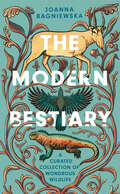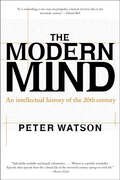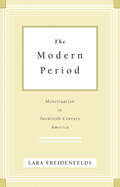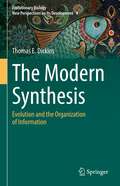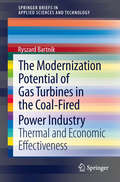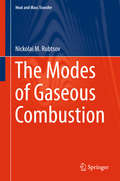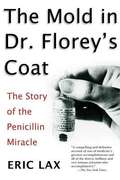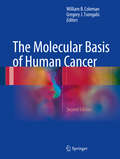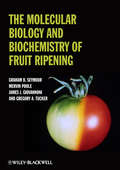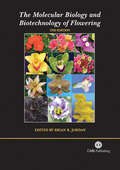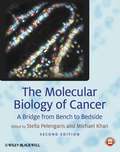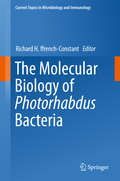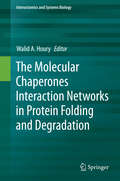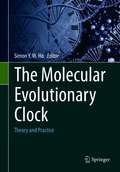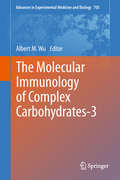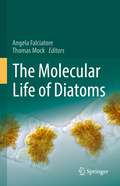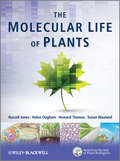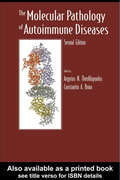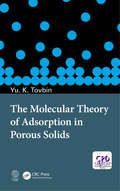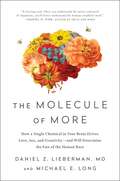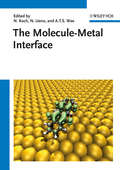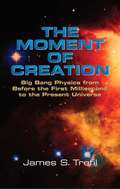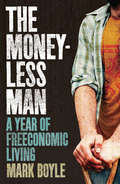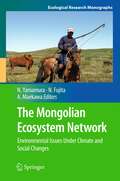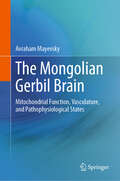- Table View
- List View
The Modern Bestiary: A Curated Collection of Wondrous Wildlife
by Joanna BagniewskaA quirky collection of Earth&’s most compelling animals who give mythical creatures a run for their moneyThe Modern Bestiary: A Curated Collection of Wondrous Wildlife mirrors the medieval tradition of an encyclopedia of incredible beasts, only this charming book with ornamental illustrations features 100 real animals who are stranger than fiction. Organized by the elements Earth, Water, and Air, the book introduces both unfamiliar creatures, like deep-sea harp sponges who catch prey in their barbs and digest them whole, as well as ones that have made headlines, such as cicadas who emerge from the ground in noisy broods every thirteen or seventeen years. Step right up and meet these delightful, unbelievable, and deliciously horrific animals, including: The endearing:same-sex albatross mothers who raise chicks togethertarantulas who keep frogs as petszebra finches who sing to their eggs to warn them of hot weatherThe ruthless:flukes who manipulate their host into getting eaten by a final hosthorned lizards who squirt blood through their eyes to distract predatorssouthern grasshopper mice who harness scorpion venom as a painkiller And the just plain weird:antechinuses who mate themselves to deathpearlfish who live, fight, and mate in sea cucumber buttsimmortal jellyfish who reverse their aging process when stressed Funny, entertaining, and illuminating, The Modern Bestiary is a book for anyone who wants to become more familiar with the natural world and all its astounding creatures.
The Modern Mind: An Intellectual History of the 20th Century
by Peter Watson“Splendidly readable and hugely informative. . . . Episode after episode from the cultural life of the twentieth century springs to vivid life.” —Boston GlobeFrom Freud to Babbitt, from Animal Farm to Sartre to the Great Society, from the Theory of Relativity to counterculture to Kosovo, The Modern Mind is encyclopedic, covering the major writers, artists, scientists, and philosophers who produced the ideas by which we live. Peter Watson has produced a fluent and engaging narrative of the intellectual tradition of the twentieth century, and the men and women who created it.“Watson’s rich narrative covers every corner of intellectual life in the twentieth century.” —Publishers Weekly“Packed with a multitude of events, ideas, and influential people, Watson’s infectious writing carries the reader swiftly along. . . . This book will be read and consulted for many years.” —Library Journal “Enthralling, illuminating, and intellectually titillating.” —Booklist
The Modern Period: Menstruation in Twentieth-Century America
by Lara FreidenfeldsWinner, 2010 Emily Toth Award for Best Book in Women’s Studies, Popular Culture Association/American Culture AssociationThe Modern Period examines how and why Americans adopted radically new methods of managing and thinking about menstruation during the twentieth century. In the early twentieth century women typically used homemade cloth "diapers" to absorb menstrual blood, avoided chills during their periods to protect their health, and counted themselves lucky if they knew something about menstruation before menarche. New expectations at school, at play, and in the workplace, however, made these menstrual traditions problematic, and middle-class women quickly sought new information and products that would make their monthly periods less disruptive to everyday life.Lara Freidenfelds traces this cultural shift, showing how Americans reframed their thinking about menstruation. She explains how women and men collaborated with sex educators, menstrual product manufacturers, advertisers, physical education teachers, and doctors to create a modern understanding of menstruation. Excerpts from seventy-five interviews—accounts by turns funny and moving—help readers to identify with the experiences of the ordinary people who engineered these changes. The Modern Period ties historical changes in menstrual practices to a much broader argument about American popular modernity in the twentieth century. Freidenfelds explores what it meant to be modern and middle class and how those ideals were reflected in the menstrual practices and beliefs of the time. This accessible study sheds new light on the history of popular modernity, the rise of the middle class, and the relationship of these phenomena to how Americans have cared for and managed their bodies.
The Modern Synthesis: Evolution and the Organization of Information (Evolutionary Biology – New Perspectives on Its Development #4)
by Thomas E. DickinsThis book is about evolutionary theory. It deals with aspects of its history to focus upon explanatory structures at work in the various forms of evolutionary theory - as such this is also a work of philosophy. Its focus lies on recent debates about the Modern Synthesis and what might be lacking in that synthesis. These claims have been most clearly made by those calling for an Extended Evolutionary Synthesis. The author argues that the difference between these two positions is the consequence of two things. First, whether evolution is a considered as solely a population level phenomenon or also a theory of form. Second, the use of information concepts. In this book Darwinian evolution is positioned as a general theory of evolution, a theory that gave evolution a technical meaning as the statistical outcome of variation, competition, and inheritance. The Modern Synthesis (MS) within biology, has a particular focus, a particular architecture to its explanations that renders it a special theory of evolution. After providing a history of Darwinian theory and the MS, recent claims and exhortations for an Extended Evolutionary Synthesis (EES) are examined that see the need for the inclusion of non-genetic modes of inheritance and also developmental processes. Much of this argument is based around claims that the MS adopts a particular view of information that has privileged the gene as an instructional unit in the emergence of form. The author analyses the uses of information and claims that neither side of the debate explicitly and formally deals with this concept. A more formal view of information is provided which challenges the EES claims about the role of genes in MS explanations of form whilst being consilient with their own interests in developmental biology. It is concluded that the MS implicitly assumed this formal view of information whilst using information terms in a colloquial manner. In the final chapter the idea that the MS is an informational theory that acts to corral more specific phenomenal accounts, is mooted. As such the book argues for a constrained pluralism within biology, where the MS describes those constraints.
The Modernization Potential of Gas Turbines in the Coal-Fired Power Industry
by Ryszard BartnikThe opportunity of repowering the existing condensing power stations by means of gas turbogenerators offers an important opportunity to considerably improvement of their energy efficiency. The Modernization Potential of Gas turbines in the Coal-Fired Power Industry presents the methodology, calculation procedures and tools used to support enterprise planning for adapting power stations to dual-fuel gas-steam combined-cycle technologies. Both the conceptual and practical aspects of the conversion of existing coal-fired power plants is covered. Discussions of the feasibility, advantages and disadvantages and possible methods are supported by chapters presenting equations of energy efficiency for the conditions of repowering a power unit by installing a gas turbogenerator in a parallel system and the results of technical calculations involving the selection heating structures of heat recovery steam generators. A methodology for analyzing thermodynamic and economic effectiveness for the selection of a structure of the heat recovery steam generator for the repowered power unit is also explained. The Modernization Potential of Gas turbines in the Coal-Fired Power Industry is an informative monograph written for researchers, postgraduate students and policy makers in power engineering.
The Modes of Gaseous Combustion
by Nickolai M. RubtsovThis book provides an analysis of contemporary problems in combustion science, namely flame propagation, detonation and heterophaseous combustion based on the works of the author. The current problems in the area of gas combustion, as well as the methods allowing to calculate and estimate limiting conditions of ignition, and flame propagation on the basis of experimental results are considered. The book focuses on the virtually inaccessible works of Russian authors and will be useful for experienced students and qualified scientists in the area of experimental studies of combustion processes.
The Mold In Dr. Florey's Coat: The Story Of The Penicillin Miracle
by Eric LaxAlexander Fleming's discovery of penicillin in his London laboratory in 1928 and its eventual development as the first antibiotic by a team at Oxford University headed by Howard Florey and Ernst Chain in 1942 led to the introduction of the most important family of drugs of the twentieth century. <P><P> Yet credit for penicillin is largely misplaced. Neither Fleming nor Florey and his associates ever made real money from their achievements; instead it was the American labs that won patents on penicillin's manufacture and drew royalties from its sale. Why this happened, why it took fourteen years to develop penicillin, and how it was finally done is a fascinating story of quirky individuals, missed opportunities, medical prejudice, brilliant science, shoestring research, wartime pressures, misplaced modesty, conflicts between mentors and their protegees, and the passage of medicine from one era to the next. <P> Includes Bibliographic references and extensive notes. At the end of the book, after the index are pages of photo captions with some image descriptions.
The Molecular Basis of Human Cancer
by William B. Coleman Gregory J. TsongalisThis book covers the concepts of molecular medicine and personalized medicine. Subsequent chapters cover the topics of genomics, transcriptomics, epigenomics, and proteomics, as the tools of molecular pathology and foundations of molecular medicine. These chapters are followed by a series of chapters that provide overviews of molecular medicine as applied broadly to neoplastic, genetic, and infectious diseases, as well as a chapter on molecular diagnostics. The volume concludes with a chapter that delves into the promise of molecular medicine in the personalized treatment of patients with complex diseases, along with a discussion of the challenges and obstacles to personalized patient care. The Molecular Basis of Human Cancer, Second Edition, is a valuable resource for oncologists, researchers, and all medical professionals who work with cancer.
The Molecular Biology and Biochemistry of Fruit Ripening
by Gregory A. Tucker Mervin Poole Graham Seymour James GiovannoniA comprehensive and mechanistic perspective on fruit ripening, emphasizing commonalities and differences between fruit groups and ripening processes. Fruits are an essential part of the human diet and contain important phytochemicals that provide protection against heart disease and cancers. Fruit ripening is of importance for human health and for industry-based strategies to harness natural variation, or genetic modification, for crop improvement.This book covers recent advances in the field of plant genomics and how these discoveries can be exploited to understand evolutionary processes and the complex network of hormonal and genetic control of ripening. The book explains the physiochemical and molecular changes in fruit that impact its quality, and recent developments in understanding of the genetic, molecular and biochemical basis for colour, flavour and texture. It is a valuable resource for plant and crop researchers and professionals, agricultural engineers, horticulturists, and food scientists.Summary:Reviews the physiochemical and molecular changes in fruit which impact flavour, texture, and colourCovers recent advances in genomics on the genetic, molecular, and biochemical basis of fruit qualityIntegrates information on both hormonal and genetic control of ripeningRelevant for basic researchers and applied scientists
The Molecular Biology and Biotechnology of Flowering
by Brian R. JordanThis book explores three main themes: the external and internal regulation of flowering, floral development, and fertilisation and gametophyte development, and includes new chapters on the evolution of flowers, floral senescence and apomixis.
The Molecular Biology of Cancer
by Mike Khan Stella PelengarisThe Molecular Biology of Cancer, Stella Pelengaris & Michael Khan This capturing, comprehensive text, extensively revised and updated for its second edition, provides a detailed overview of the molecular mechanisms underpinning the development of cancer and its treatment. "Bench to Bedside": A key strength of this book that sets it apart from general cancer biology references is the interweaving of all aspects of cancer biology from the causes, development and diagnosis through to the treatment and care of cancer patients - essential for providing a broader view of cancer and its impact. The highly readable presentation of a complex field, written by an international panel of researchers, specialists and practitioners, would provide an excellent text for graduate and undergraduate courses in the biology of cancer, medical students and qualified practitioners in the field preparing for higher exams, and for researchers and teachers in the field. For the teaching of cancer biology, special features have been included to facilitate this use: bullet points at the beginning of each chapter explaining key concepts and controversial areas; each chapter builds on concepts learned in previous chapters, with a list of key outstanding questions remaining in the field, suggestions for further reading, and questions for student review. All chapters contain text boxes that provide additional and relevant information. Key highlights are listed below: An overview of the cancer cell and important new concepts. Selected human cancers: lung, breast, colorectal, prostate, renal, skin, cervix, and hematological malignancies. Key cellular processes in cancer biology including (a) traditionally important areas such as cell cycle control, growth regulation, oncogenes and tumour suppressors apoptosis, as well as (b) more highly topical areas of apoptosis, telomeres, DNA damage and repair, cell adhesion, angiogenesis, immunity, epigenetics, and the proteasome. Clinical oncology: In-depth coverage of important concepts such as screening, risk of cancer and prevention, diagnoses, managing cancer patients from start to palliative care and end-of-life pathways.Chapters highlighting the direct links between cancer research and clinical applications. New coverage on how cancer drugs are actually used in specific cancer patients, and how therapies are developed and tested. Systems Biology and cutting edge research areas covered such as RNA interference (RNAi). Each chapter includes key points, chapter summaries, text boxes, and topical references for added comprehension and review. Quotations have been used in each chapter to introduce basic concepts in an entertaining way.Supported by a dedicated website at www.blackwellpublishing.com/pelengaris We should list the great reviews we got for first edition which are on the back of the 2nd edition:"A capturing, comprehensive, clearly written and absolutely accurate introduction into cancer biology.....This book deserves great praise for the readable presentation of this complex field....the true synthesis of bench and bedside approaches is marvelously achieved." Christian Schmidt, Molecular Cell"Chapters address the issues of cancer diagnosis, treatment, and patient care and set the book apart from general molecular biology references....This book is applicable to both graduate and undergraduate students, and in the context of a research laboratory, this book would be an excellent resource as a reference guide for scientists at all levels." V.Emuss, Institute of Cancer Research, London.Also, from the first edition:"Pelengaris, Khan, and the contributing authors are to be applauded. The Molecular Biology of Cancer is a comprehensive and readable presentation of the many faces of cancer from molecular mechanisms to clinical therapies and diagnostics. This book will be welcomed by neophyte students, established scientists in other fields, and curious physicians." -Dean Felsher, Stanford University
The Molecular Biology of Photorhabdus Bacteria
by Richard H. ffrench-ConstantThis book provides an essential update on the startling array of novel insecticidal toxins and drugs produced by the fascinating bacterium Photorhabdus. The respective chapters describe everything from the detailed molecular biology of the 'Toxin complexes' or Tc's to the complexity of insect immune response in relation to both the bacterium and its nematode vector. The volume covers both primary (toxin production and regulation) and secondary (natural product synthesis and regulation) metabolism and emphasises the potential use of toxins and drugs in both agriculture and medicine. It also discusses in detail two totally novel quorum sensing mechanisms and the likely role of LuxR solos in sensing the presence of different bacterial hosts. Lastly, the book explores the unique case of P. asymbiotica, which seems to have evolved the ability to infect both insects and humans. This synthesis proves that Photorhabdus truly does offer a 'gold mine' for the discovery of novel insecticidal proteins and novel natural products with potential uses in agriculture and medicine alike.
The Molecular Chaperones Interaction Networks in Protein Folding and Degradation
by Walid A. HouryMolecular chaperones are a fundamental group of proteins that have been identified only relatively recently. They are key components of a protein quality machinery in the cell which insures that the folding process of any newly-synthesized polypeptide chain results in the formation of a properly folded protein and that the folded protein is maintained in an active conformation throughout its functional lifetime. Molecular chaperones have been shown to play essential roles in cell viability under both normal and stress conditions. Chaperones can also assist in the unfolding and degradation of misfolded proteins and in disaggregating preformed protein aggregates. Chaperones are also involved in other cellular functions including protein translocation across membranes, vesicle fusion events, and protein secretion. In recent years, tremendous advances have been made in our understanding of the biology, biochemistry, and biophysics of function of molecular chaperones. In addition, recent technical developments in the fields of proteomics and genomics allowed us to obtain a global view of chaperone interaction networks. Finally, there is now a growing interest in the role of molecular chaperones in diseases. This book will provide a comprehensive analysis of the structure and function of the diverse systems of molecular chaperones and their role in cell stress responses and in diseases from a global network perspective.
The Molecular Evolutionary Clock: Theory and Practice
by Simon Y. W. HoThis book presents coverage of the principles and practice of molecular clocks, which have provided fascinating and unprecedented insights into the evolutionary timescale of life on earth. It begins by following the early development of the molecular evolutionary clock in the 1960s, and leads to the complex statistical approaches that are now used to analyse genome sequences. The chapters of this book have been contributed by leading experts in the field and address the important issues of evolutionary rates, molecular dating, and phylogenomic analysis. This is the first time that these different aspects of the molecular clock have been brought together in a single, comprehensive volume. It is an invaluable reference for students and researchers interested in evolutionary biology, genetic analysis, and genomic evolution.
The Molecular Immunology of Complex Carbohydrates-3
by Albert M. WuBased on the third symposium on "Molecular Immunology of Complex Carbohydrates," this text covers the latest in glycotopes, structures and functions of complex carbohydrates, recognition factors of lectins, biomolecular interactions and other glycosciences. This volume highlights the informative events of the Symposium on Molecular Immunology of Complex Carbohydrates III, held at the Institute of Biological Chemistry, Academia Sinica, on July 15-20, 2007, in Taipei, Taiwan.
The Molecular Life of Diatoms
by Angela Falciatore Thomas MockDiatoms are the most species rich group of algae, and they contribute about 20% of annual global carbon fixation. They play major roles in ocean food webs and global biogeochemical cycles. They are also a target of the biotechnology industry because of their nano-patterned silica cell wall and high lipid content. Diatoms have received increasing attention as more genomes became available and because of the development of genome editing tools such as the CRISPR/Cas9 technology, which has made diatoms as genetically tractable as well-established biological model species. This book provides an overview on diatom molecular biology. It brings together international leading experts in the field to discuss the latest data and developments from genes to ecosystems. As the understanding of diatoms is currently experiencing a step change, it is critical to allow for synergistic approaches on diverse aspects of diatom biology and evolution. The books offers fundamental insights into the molecular life of diatoms; at the same time new scientific concepts are developed based on the application of the latest molecular tools and genomic information to explore the fascinating lifestyle of diatoms.
The Molecular Life of Plants
by Howard Thomas Russell Jones Helen Ougham Susan WaalandA stunning landmark co-publication between the American Society of Plant Biologists and Wiley-Blackwell.The Molecular Life of Plants presents students with an innovative, integrated approach to plant science. It looks at the processes and mechanisms that underlie each stage of plant life and describes the intricate network of cellular, molecular, biochemical and physiological events through which plants make life on land possible. Richly illustrated, this book follows the life of the plant, starting with the seed, progressing through germination to the seedling and mature plant, and ending with reproduction and senescence. This "seed-to-seed" approach will provide students with a logical framework for acquiring the knowledge needed to fully understand plant growth and development.Written by a highly respected and experienced author team The Molecular Life of Plants will prove invaluable to students needing a comprehensive, integrated introduction to the subject across a variety of disciplines including plant science, biological science, horticulture and agriculture.
The Molecular Pathology of Autoimmune Diseases
by Argyrios N.Theofilopoulos and Constantin A.BonaRemarkable advances have been made in the pathogenesis of autoimmunity, such as with bone marrow transplantation, which is becoming a powerful strategy in treating certain life-threatening diseases. The Molecular Pathology of Autoimmune Diseases is a concise and centralized resource for information on the topic, with a special focus on the molecula
The Molecular Theory of Adsorption in Porous Solids
by Yury Konstantinovich TovbinIn the adsorption phenomenon the substances from the external environment the gas or liquid are absorbed by a solid surface (adsorbent). Adsorption is used to separate gaseous and liquid mixtures, for drying and purification of gases and liquids. This reference broadly explores the calculation of the equilibrium and dynamic characteristics of adsorption in porous bodies at the molecular level. Two new theories of statistical physics are presented, both developed by the author for the consistent description of the equilibrium distribution of molecules and dynamics of flows in complex porous materials to be able to solve a wide range of practical tasks in the development of new technologies.
The Molecule of More: How a Single Chemical in Your Brain Drives Love, Sex, and Creativity--and Will Determine the Fate of the Human Race
by Daniel Z. Lieberman Michael E. LongWhy are we obsessed with the things we want only to be bored when we get them? Why is addiction perfectly logical to an addict? Why does love change so quickly from passion to indifference? Why are some people die-hard liberals and others hardcore conservatives? Why are we always hopeful for solutions even in the darkest times—and so good at figuring them out? The answer is found in a single chemical in your brain: dopamine. Dopamine ensured the survival of early man. Thousands of years later, it is the source of our most basic behaviors and cultural ideas—and progress itself. Dopamine is the chemical of desire that always asks for more—more stuff, more stimulation, and more surprises. In pursuit of these things, it is undeterred by emotion, fear, or morality. Dopamine is the source of our every urge, that little bit of biology that makes an ambitious business professional sacrifice everything in pursuit of success, or that drives a satisfied spouse to risk it all for the thrill of someone new. Simply put, it is why we seek and succeed; it is why we discover and prosper. Yet, at the same time, it's why we gamble and squander. From dopamine's point of view, it's not the having that matters. It's getting something—anything—that's new. From this understanding—the difference between possessing something versus anticipating it—we can understand in a revolutionary new way why we behave as we do in love, business, addiction, politics, religion—and we can even predict those behaviors in ourselves and others. In The Molecule of More: How a Single Chemical in Your Brain Drives Love, Sex, and Creativity—and will Determine the Fate of the Human Race, George Washington University professor and psychiatrist Daniel Z. Lieberman, MD, and Georgetown University lecturer Michael E. Long present a potentially life-changing proposal: Much of human life has an unconsidered component that explains an array of behaviors previously thought to be unrelated, including why winners cheat, why geniuses often suffer with mental illness, why nearly all diets fail, and why the brains of liberals and conservatives really are different.
The Molecule-Metal Interface
by Nobuo Ueno Andrew Thye Wee Norbert KochReviewing recent progress in the fundamental understanding of the molecule-metal interface, this useful addition to the literature focuses on experimental studies and introduces the latest analytical techniques as applied to this interface. The first part covers basic theory and initial principle studies, while the second part introduces readers to photoemission, STM, and synchrotron techniques to examine the atomic structure of the interfaces. The third part presents photoelectron spectroscopy, high-resolution UV photoelectron spectroscopy and electron spin resonance to study the electronic structure of the molecule-metal interface. In the closing chapter the editors discuss future perspectives. Written as a senior graduate or senior undergraduate textbook for students in physics, chemistry, materials science or engineering, the book's interdisciplinary approach makes it equally relevant for researchers working in the field of organic and molecular electronics.
The Moment of Creation: Big Bang Physics from Before the First Millisecond to the Present Universe
by James S. Trefil"Trefil surpasses almost all other scientists writing about science." -- The New York Times"Fascinating reading. A mind-stretching book." -- John Barkham ReviewsOne of the founders of modern quark theory traverses the eons to bring readers within the first millisecond of the Big Bang. Trefil employs minimal mathematics in this compelling and lucid narrative, which not only offers a remarkable view of the universe's beginnings, but also speculates about its end. Compelling and lucid, this reader-friendly narrative travels billions of years back in time to depict the events that culminated in the Big Bang: the colossal explosion that initiated the existence of the universe. James Trefil is one of the founders of modern quark theory, and he specializes in explaining complex scientific matters to nonspecialists. 1983 edition.
The Moneyless Man
by Mark BoyleThe astonishing reality of living without our most important resource. Imagine a year without spending any money. Former businessman Mark Boyle did just that and here is his extraordinary and compelling story. Going back to basics and following his own strict rules, Mark learned ingenious ways to eliminate his bills and flourish for free. Encountering seasonal foods, solar panels, skill-swapping schemes, cuttlefish toothpaste, compost toilets and - the unthinkable - a cash-free Christmas, Boyle puts the fun into frugality and offers some great tips for economical (and environmentally friendly) living. Highlighting the huge wastage inherent in modern Western living - we throw away a third of our food - Mark explains how to feed yourself for free with "the four legs of the food-for-free table". From making paper out of mushrooms and to constructing a rocket stove from discarded catering cans, Mark advocates a return to local economics where we can see the consequences of what we consume. Heart-warming and witty, learn how Mark's mission affected his relationships. What did his parents think of his crusade? Can you keep a girlfriend when you are moneyless? Do your friends keep in contact when you can't go out for a beer? A testament to Mark's astounding determination, this thought-provoking book will make you re-evaluate your relationship to your wallet. Mark Boyle has founded the worldwide 'freeconomic' movement. An economics graduate and former business director, he is Irish and lives in Bristol in the UK. His website (justfortheloveofit.org) receives up to 30,000 hits a day and has become a hub for community sharing with over 17,000 members worldwide (many in the US). His story has been reported worldwide and he is an excellent self-publicist. He has been covered in media including: Wall Street Journal, CNN, Huffington Post, New York Metro, BBC World Service, Guardian of London, Sky News, The Times of London, The Star of Canada, La Presse of Canada. Mark is lined up to be interviewed on CNN shortly as The Connector of the Day - a slot which goes out to 300 million people worldwide. He also plans to do a moneyless tour of the US to coincide with publication, where based on previous coverage, he expects major press interest. As he will be hitch-hiking (illegal in the US) and promoting this, he expects more publicity if and when he is arrested.
The Mongolian Ecosystem Network
by Ai Maekawa Noboru Fujita Norio YamamuraThe aim of this book is to describe what is currently occurring in the Mongolian grasslands, to analyze how various factors creating environmental problems interact, and to suggest solutions for sustainable management of the grasslands. The book has three parts. Part I is an introduction, explaining the key concept of an ecosystem network and providing background information on the general features of Mongolian nomadic pastoralism as well as distribution of vegetation in Mongolian grasslands. Part II describes the effects of natural environmental factors and nomadic activities on grassland conditions. Water dynamics that maintain the grassland system are analyzed in a steppe region with shrubs and in a forest-steppe region with trees. Part III describes the effects of economic and social factors on land-use and the livelihood of herders. As nomadic people moved closer to large cities for economic advantage in the 1990s, degradation of pastures by overgrazing resulted. Finally, the impacts of global warming and globalization on the Mongolian society and ecosystem are examined. This book analyzes environmental problems in Mongolian grasslands, but the contents contribute to consideration of environmental problems and sustainable pasture use in grassland areas worldwide.
The Mongolian Gerbil Brain: Mitochondrial Function, Vasculature, and Pathophysiological States
by Avraham MayevskyThe Mongolian gerbil brain lies in the anatomy of the blood vessels supplying blood to the brain. In all mammals, there is a special mechanism that compensates for the decreased blood flow to the brain in the case of development of stroke. This mechanism is missing in the gerbil and therefore makes the Mongolian gerbil a unique model for stroke. Dr. Mayevsky adopted the gerbil as a model for stroke and his laboratory uniquely studied the mitochondria in the gerbil brain under various pathophysiological conditions.This book describes the history of the Mongolian gerbil in research, the brain energy metabolism and mitochondrial function and brain real-time monitoring systems used in gerbils, as well as the brain vasculature of the Mongolian gerbil. Further, the book includes chapters on brain multisite recording under brain perturbations, multiparametric responses to brain activation, and the effect of neuroprotectants on the gerbil brain. This is an ideal book for research teams researching stroke and epilepsy.
